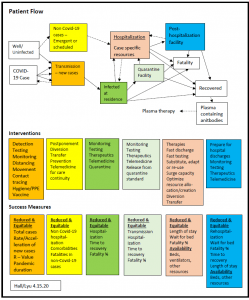In an epidemic, patient flow spans the time from disease transmission to patient recovery (or death), along with options for intervention and measures of success.
Disease is transmitted from individual to individual within communities and regions, and between regions as people travel from place to place. The frequency of travel and incidence of disease among travelers affect rates at which disease is imported or exported between regions, or to/from special populations, such as those living in congregate living settings, such as skilled nursing.
Capacity, as with need (resulting from number and severity of cases) varies over time, as resources, such as ICU beds, medicine, Personal Protective Equipment, medical staff, and ventilators, are acquired or re-located. Likewise, patient requirements are met by reducing the occurrence of disease and the need for hospitalization. This means matching capacity/resources to need, recognizing the rate of transmission will vary from day to day, the consequence of transmission will vary from person to person, the requirements for health services will vary during an individual’s course of the disease, and the availability of health care services can be correlated with ethnicity and other demographic factors.

